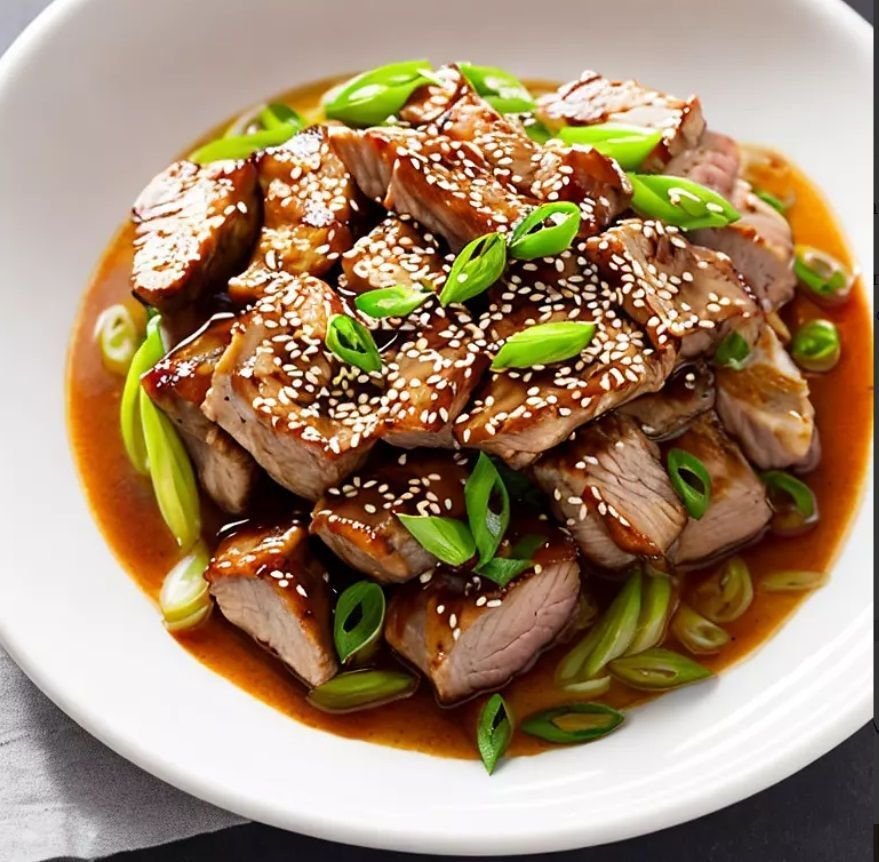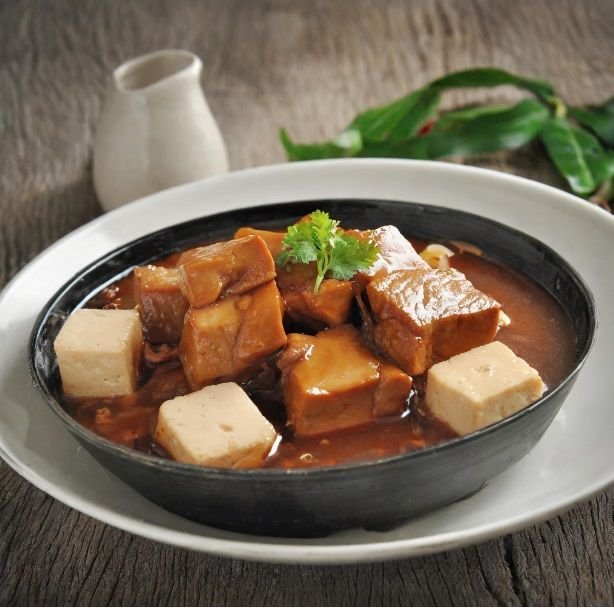Chicken with brown bean sauce
Chicken with brown bean sauce
Chicken with brown bean sauce is a delicious Chinese dish often associated with the cuisine of East China. It’s a savory and flavorful dish that combines chicken with a rich brown bean sauce. Here’s a basic recipe to make it:
Ingredients:
- 2 boneless, skinless chicken breasts, cut into bite-sized pieces
- 2 tablespoons vegetable oil
- 2 cloves garlic, minced
- 1-inch piece of fresh ginger, minced
- 2 tablespoons fermented brown bean sauce (also known as brown bean paste or douchi)
- 1 tablespoon soy sauce
- 1 teaspoon sugar
- 1/2 cup chicken broth
- 1 red bell pepper, thinly sliced
- 1 green bell pepper, thinly sliced
- 1 small onion, thinly sliced
- 1 tablespoon cornstarch mixed with 2 tablespoons water (cornstarch slurry)
- Chopped green onions for garnish
Instructions:
- In a wok or a large skillet, heat the vegetable oil over medium-high heat.
- Add the minced garlic and ginger and stir-fry for about 30 seconds until fragrant.
- Add the chicken pieces and cook until they are no longer pink, about 4-5 minutes.
- Push the chicken to one side of the wok and add the brown bean sauce to the other side. Stir and cook the sauce for a minute or so until it becomes fragrant.
- Mix the chicken and brown bean sauce together in the wok.
- Add the soy sauce, sugar, and chicken broth to the wok. Stir well to combine.
- Add the sliced bell peppers and onion to the wok and stir-fry for another 2-3 minutes, or until the vegetables are tender-crisp.
- Give the cornstarch slurry a quick stir and pour it into the wok. Stir continuously until the sauce thickens.
- Once the sauce has thickened and everything is well combined, remove the wok from the heat.
- Garnish with chopped green onions.
- Serve the chicken with brown bean sauce over steamed rice.
This dish has a savory and slightly salty flavor from the brown bean sauce, with a hint of sweetness from the sugar. It’s a great way to enjoy chicken with a unique and delicious East Chinese twist. Enjoy your meal!

Chinese soy sauce, also known as “酱油” (jiàngyóu) in Mandarin, is a fundamental and versatile condiment in Chinese cuisine. It plays a pivotal role in enhancing the flavor, color, and aroma of countless Chinese dishes.
In this essay, we will delve into the world of Chinese soy sauce, exploring its history, production methods, types, culinary uses, and cultural significance. Here we will provide you a comprehensive overview of this traditional sauce.
History: this sauce is deeply rooted in Chinese history, with origins dating back over 2,500 years. It is believed to have been created during the Western Han Dynasty (206 BC to 9 AD) and was first mentioned in texts from the 3rd century BC.
The earliest soy sauces were quite different from what we know today, often made with a simple mixture of soybeans, wheat, and salt that was fermented over time. This sauce gradually evolved in taste and production methods, becoming a cornerstone of Chinese culinary culture.
Production Methods: this sauce is traditionally made through a natural fermentation process that can take several months to several years. The key ingredients in this sauce production are soybeans, wheat, salt, and water. Here’s a simplified overview of the production process:
- Preparation: Soybeans and wheat are roasted and crushed into a coarse powder.
- Koji Cultivation: The mixture is combined with a special type of mold (koji) that initiates fermentation.
- Fermentation: The koji-inoculated mixture is mixed with salt and water to form a mash. It is then allowed to ferment in large containers or barrels for an extended period.
- Pressing: After fermentation, the mash is pressed to extract the liquid, which is the soy sauce. The remaining solid residue is often used in animal feed.
- Aging: this sauce is aged to develop its flavor and aroma. The aging process can vary from a few months to several years.
Types of Chinese Soy Sauce:
Chinese sauce can be broadly categorized into two main types:
- Light Soy Sauce (生抽, shēngchōu): This is the most commonly used sauce in Chinese cuisine. It is lighter in color and flavor, and it is used to enhance and season dishes. Light sauce is often added during cooking to add saltiness and depth of flavor.
- Dark Soy Sauce (老抽, lǎochōu): Dark sauce has a richer and more intense flavor. It is aged for a longer time and has a thicker consistency. Dark sauce is primarily used for color and to give a slightly sweet, caramelized note to dishes. It is often used for marinating, braising, and in dishes like Red-cooked Pork.
There are also regional variations of soy sauce in China, with some areas having their own unique styles and flavors. For example, Shandong province is known for its fragrant, savory sauce, while Guangdong province produces a lighter, sweeter variety.

Culinary Uses:
Chinese soy sauce is an incredibly versatile ingredient that is used in various ways:
- Marinades: is commonly used as a base for marinades, adding depth of flavor to meats and vegetables. For example, it is an essential component in preparing Chinese barbecue (char siu).
- Seasoning: is used as a seasoning to add saltiness and umami to a wide range of dishes, from stir-fries to soups and steamed dishes.
- Dipping Sauce: It is frequently served as a dipping sauce for dumplings, spring rolls, and other appetizers.
- Braising and Stewing: Dark sauce is a key ingredient in dishes that involve slow cooking, such as Red-cooked Pork and soy-braised chicken.
- Fried Rice and Noodles: is often added to fried rice and noodle dishes for both flavor and color.
- Salad Dressings: Light sauce can be used as a component of salad dressings to introduce a savory element.
- Table Condiment: In some regions, a bottle of soy sauce is placed on the dining table for diners to adjust the flavor of their dishes according to their preferences.
Cultural Significance:
This type of sauce is not only a culinary staple but also holds cultural significance in China. It symbolizes harmony and balance in Chinese philosophy. Its umami-rich flavor complements a variety of ingredients, reflecting the importance of balance and harmony in Chinese cooking and culture.
It is used in traditional celebrations, such as Chinese New Year, to symbolize the wish for a flavorful and harmonious life.
In conclusion, Chinese soy sauce is a fundamental element of Chinese cuisine with a rich history, diverse types, and versatile culinary uses. It has evolved over millennia, playing a central role in the development of Chinese gastronomy.
Its cultural and culinary importance extends far beyond Chinese borders, as this sauce is now widely appreciated and used in kitchens around the world. Whether it’s used to season, marinate, or as a dipping sauce, this Chinese sauce remains a cornerstone of the Chinese culinary tradition.

Usage of poultry in the chinese cuisine
- Kung Pao Poultry (宫保鸡丁, Gōng Bǎo Jī Dīng): This is a popular Sichuan dish made with diced poultry, peanuts, and a spicy, savory sauce. It typically includes Sichuan peppercorns for a numbing and spicy flavor.
- Sweet and Sour poultry (糖醋鸡, Táng Cù Jī): This dish features battered and deep-fried poultry pieces served with a tangy, sweet, and sour sauce. It’s a classic in Chinese-American cuisine.
- General Tso’s poultry (左宗棠鸡, Zuǒ Zōng Táng Jī): A well-known Chinese-American dish, General Tso’s poultry consists of deep-fried poultry chunks in a sweet and slightly spicy sauce.
- Dongpo poultry (东坡鸡, Dōng Pō Jī): This dish involves simmering poultry in a rich and flavorful sauce made with soy sauce, wine, sugar, and spices. It’s named after the famous Chinese poet and statesman Su Dongpo.
- Chinese poultry Salad (中式鸡沙拉, Zhōngshì Jī Shālā): A lighter dish, this salad typically features poached or grilled poultry served with a variety of vegetables and a soy-based dressing.
- Peking Duck (北京烤鸭, Běijīng Kǎoyā): While it’s primarily known for its crispy duck skin, Peking Duck can also be served with thin pancakes, where the duck meat is wrapped with condiments like hoisin sauce, cucumbers, and scallions.
- Poultry Congee (鸡粥, Jī Zhōu): Congee is a rice porridge, and poultry congee is a soothing and comforting dish made by simmering poultry and rice together. It is often garnished with toppings like green onions, fried garlic, and soy sauce.
- Poultry and Mushroom Stir-Fry (鸡蓉香菇, Jī Róng Xiānggū): This stir-fry features poultry slices with various mushrooms and is often seasoned with soy sauce, oyster sauce, and other aromatic ingredients.
- Hot and Sour Soup (酸辣汤, Suān là Tāng): While this soup can include other proteins, poultry is sometimes used. It combines the flavors of spicy and sour in a comforting broth.
- Sesame poultry (芝麻鸡, Zhīma Jī): Similar to General Tso’s poultry, this dish consists of battered and deep-fried poultry pieces coated in a sweet sesame sauce.
- Salt and Pepper poultry (椒盐鸡, Jiāoyán Jī): This is a popular street food in China, featuring bite-sized pieces of poultry deep-fried and seasoned with salt and Sichuan peppercorns for a spicy kick.
- Diced poultry with Cashew Nuts (腰果鸡丁, Yāoguǒ Jī Dīng): This dish combines diced poultry, cashew nuts, and vegetables in a savory sauce, often with a hint of sweetness.
- Sichuan Duck Blood Hot Pot (鸭血火锅, Yāxiě Huǒguō): In Sichuan cuisine, duck blood is sometimes used in hot pot dishes, where it is simmered in a spicy broth alongside other ingredients.
- Cantonese Salt-Baked poultry (盐焗鸡, Yán Jú Jī): This traditional Cantonese dish involves marinating poultry with salt and spices, then baking it in a salt crust for a unique and flavorful preparation.
- Poultry Soup with Chinese Herbs (药材鸡汤, Yào Cái Jī Tāng): In traditional Chinese medicine, various herbs and ingredients are added to poultry soup to create nourishing and healing concoctions.
These are just a few examples of the diverse uses of poultry in Chinese cuisine. The culinary traditions of China offer a wide array of flavors, cooking methods, and regional specialties that showcase the versatility of poultry and duck in the kitchen.
Whether it’s in the spicy dishes of Sichuan, the sweet and savory flavors of Cantonese cuisine, or the comforting soups found throughout China, poultry is a central and beloved ingredient in Chinese cooking.



